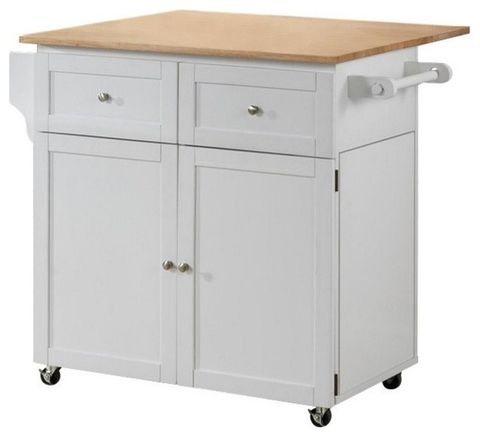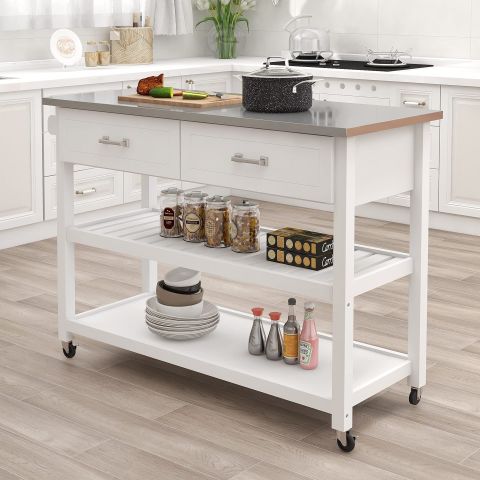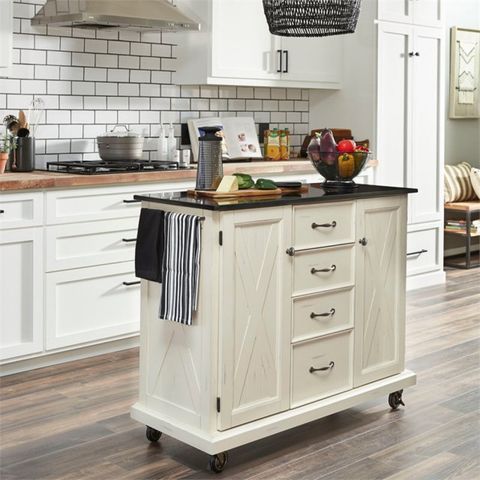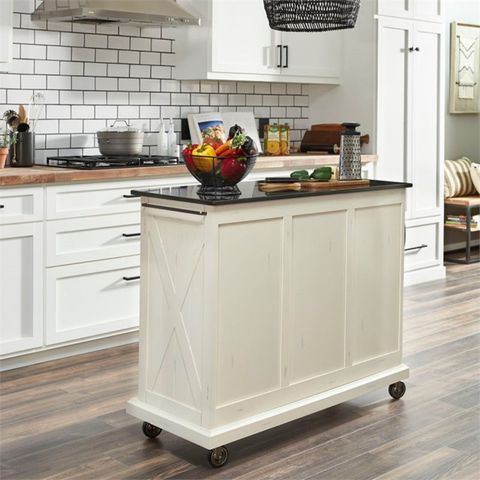Let’s be truthful, kitchens, no matter their size, often face a similar problem: a lack of room. Counter space vanishes faster than cookies at a bake sale, and finding a place for all your cooking essentials can feel like a never-ending game of Tetris. That’s where the humble kitchen cart swoops in to save the day. It’s not just a piece of furniture; it’s a game-changer, a versatile friend, and your new best buddy in the culinary world. This guide will walk you through everything you need to know to choose the perfect kitchen cart, and how to utilize it, and make your kitchen the most organized, and enjoyable space in your home. Ready to declutter and start cooking with ease?
Think of a kitchen cart as an extra pair of hands (and storage!). They’re the unsung heroes of the kitchen, offering extra workspace, storage, and a touch of style. Whether you’re a seasoned chef or a casual cook, a well-chosen kitchen cart can dramatically improve your kitchen’s functionality. They’re especially helpful if you’re dealing with a small kitchen, an apartment, or just want to free up some counter space. This guide will give you the knowledge you need to navigate the world of kitchen carts, from understanding the different types available to deciding which features best suit your needs. Let’s get started, shall we?
Understanding the Different Types of Kitchen Carts
Kitchen carts come in all shapes, sizes, and designs. Knowing the main types will help you narrow down your search. Here’s a quick rundown:
- Rolling Kitchen Carts: These are perhaps the most popular. They’re mobile (thanks to those handy wheels!), making them perfect for small kitchens or those who like to rearrange often. They often include a butcher block or stainless steel top for food prep, and shelves or drawers for storage.
- Island Carts: These carts are usually larger, designed to act as a small island. They offer more workspace, often include seating, and provide ample storage. They’re great for kitchens that need a central prep area.
- Drop-Leaf Kitchen Carts: These are space-savers. They have a folding countertop that expands your workspace when needed and folds down when you need more room.
- Bakers Racks with Cart Features: These carts combine the open shelving of a bakers rack with the mobility of a cart. They’re fantastic for displaying cookbooks, storing appliances, and providing a bit of extra counter space.
- Corner Kitchen Carts: Designed to fit snugly into corners, these carts are an excellent way to utilize often-wasted space.
Key Features to Consider Before You Buy
Beyond the type of cart, several features will impact its usefulness and how well it fits your lifestyle. Think about these things before you commit:
- Size and Space: Measure your kitchen and the space you’re planning to put the cart. Make sure it won’t block walkways or make your kitchen feel cramped. Consider the height of the cart, too – will it be comfortable for you to work at?
- Storage Needs: Do you need drawers for utensils, shelves for pots and pans, or a wine rack? Think about what you’ll be storing to determine the right cart layout.
- Countertop Material: Butcher block tops are great for chopping, stainless steel is hygienic, and granite or marble offer a touch of elegance and durability. Consider what will work best for your cooking habits.
- Mobility: If you plan to move the cart around, make sure it has sturdy wheels that lock in place. Look for wheels that can handle the weight of the cart and its contents.
- Material and Durability: Kitchen carts are made from various materials, like wood, metal, and composite materials. Consider the overall quality and how it will hold up to daily use and the kitchen environment. Wood carts are classic, but might require more maintenance. Metal can be more durable and easier to clean.
- Style: Do you have a modern, rustic, or traditional kitchen? Choose a cart that complements your existing decor. It’s all about creating a cohesive feel.
Choosing the Right Countertop for Your Needs
The countertop is the heart of your kitchen cart. It’s where you’ll chop vegetables, knead dough, and assemble your culinary creations. Your choice of countertop material is crucial, so choose wisely:
- Butcher Block: A classic choice, butcher block offers a warm, inviting look and is ideal for food preparation. It’s great for chopping and cutting but requires regular oiling and maintenance to prevent drying and cracking.
- Pros: Durable, attractive, good for chopping.
- Cons: Requires maintenance, can stain.
- Stainless Steel: A hygienic and easy-to-clean option, stainless steel is a favorite for serious cooks. It’s heat-resistant and won’t stain.
- Pros: Hygienic, easy to clean, heat-resistant.
- Cons: Can scratch easily, can show fingerprints.
- Granite and Marble: These natural stones offer elegance and durability. They’re heat-resistant and easy to clean, but they can be expensive.
- Pros: Elegant, durable, heat-resistant.
- Cons: Expensive, can stain if not sealed properly.
- Laminate: A more budget-friendly option, laminate countertops are available in a wide variety of colors and patterns. They’re easy to clean but can scratch easily.
- Pros: Affordable, easy to clean.
- Cons: Can scratch, not heat-resistant.
Maximizing Your Kitchen Cart’s Functionality
Once you have your kitchen cart, the real fun begins: making it work for you. Here are some tips to maximize its functionality:
- Organize, Organize, Organize: Use drawers for utensils, shelves for pots and pans, and baskets for produce. Everything should have its place.
- Create Zones: Dedicate areas for specific tasks, such as food prep, baking, or coffee making. This will make your kitchen more efficient.
- Utilize Vertical Space: Hang utensils from hooks, add shelves to maximize storage, and use spice racks to keep things tidy.
- Think About Accessories: Consider adding a knife block, a paper towel holder, or a trash can to your cart to make it even more functional.
- Keep it Clean: Wipe down your cart regularly to keep it looking its best and to prevent the build-up of food particles. A clean cart is a happy cart.
Real-World Examples: Kitchen Cart Success Stories
Let’s look at a few real-life situations where a kitchen cart made all the difference:
- The Small Apartment Cook: Sarah lived in a tiny studio apartment. A rolling kitchen cart with a butcher block top became her primary prep area and provided extra storage for her cookware. The fact it was moveable meant she could shift it around when needed.
- The Baking Enthusiast: Michael loved to bake, but his kitchen was short on space. He found a cart with a pull-out cutting board, a large drawer for baking supplies, and shelves for his stand mixer and other appliances. It transformed his baking experience.
- The Coffee Connoisseur: Emily created a coffee station on her kitchen cart, complete with a coffee maker, a grinder, a milk frother, and storage for coffee beans and mugs. It became her favorite spot in the morning, and it kept her counter free from clutter.
- The Family Kitchen: The Jones family’s kitchen lacked a central island. They chose a large island cart with seating, drawers for utensils, and shelves for pots and pans. It became the hub of their kitchen, a place for homework, casual meals, and family gatherings. And it helped keep the main counter space free from clutter.
Common Mistakes to Avoid When Buying a Kitchen Cart
To ensure you choose the right kitchen cart, avoid these common pitfalls:
- Not Measuring Your Space: This is the biggest mistake. Always measure your kitchen to ensure the cart will fit comfortably and won’t impede traffic flow.
- Ignoring Your Storage Needs: Buy a cart that provides the right amount of storage for your needs. Consider the types of items you’ll be storing (pots, pans, utensils, etc.) and choose the cart accordingly.
- Choosing Style Over Function: While you want a cart that looks good, prioritize functionality. Make sure the cart has the features you need to make your cooking experience easier.
- Overlooking the Material: Consider the durability and maintenance requirements of different materials. You want a cart that will last.
- Not Considering the Wheels: If you want a mobile cart, make sure the wheels are durable and lock in place. Otherwise, your cart will be constantly moving around.
Choosing the right kitchen cart can transform your kitchen from cramped and cluttered to organized and efficient. By considering your needs, understanding the different types and features, and avoiding common mistakes, you can find the perfect cart to enhance your cooking experience. So, take the plunge, do some research, and get ready to enjoy a more functional, and stylish kitchen. Happy cooking. And remember, a well-chosen kitchen cart is more than just a piece of furniture – it’s an investment in your kitchen, your cooking, and your peace of mind. It’s about creating a kitchen that works for you, and a kitchen cart is a fantastic starting point. Now go forth, and conquer your kitchen clutter.




















